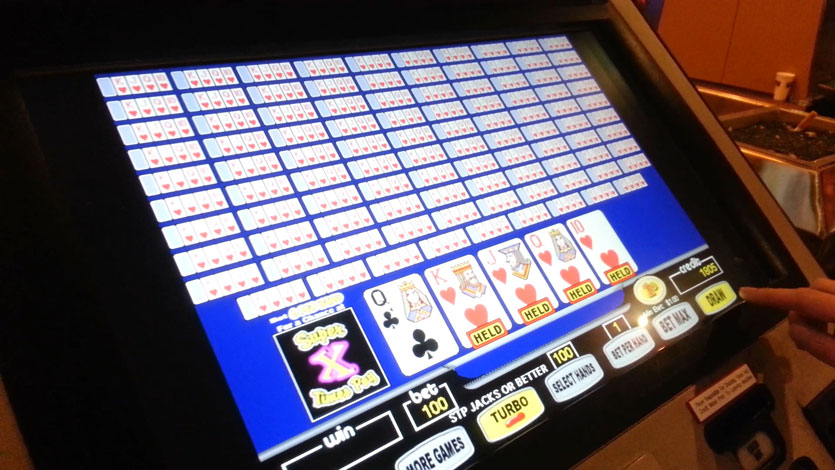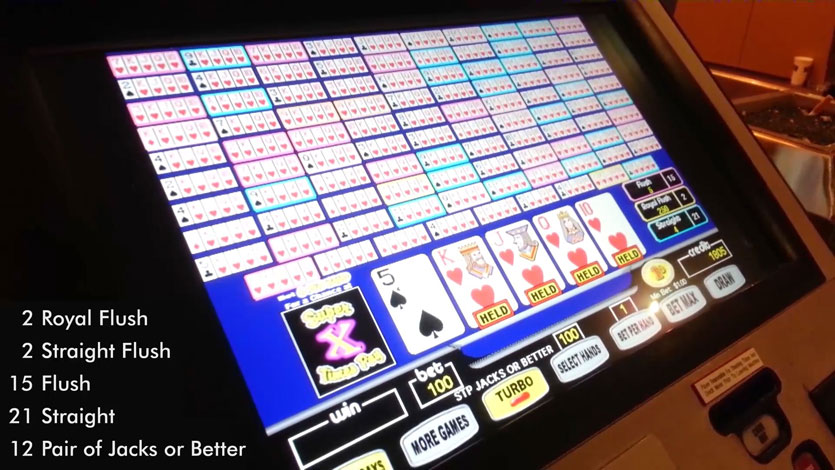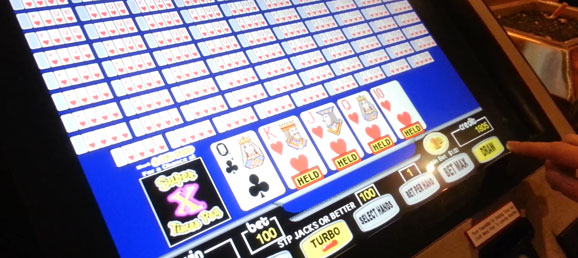




She decides to hold only these four cards:




When she presses the “DRAW” button, each of the hundred hands will begin with the four cards she held and she will get a new fifth card on each of the hundred hands that is drawn from a different deck of cards.
- How many Royal Flushes would you expect the woman to get?
- How many straight flushes would you expect the woman to get?
- How many flushes would you expect the woman to get?
- How many straights would you expect the woman to get?
- How many pairs of Jacks or better would you expect the woman to get?
- What is a guess that is too low?
- What is a guess that is too high?
- What is your best guess?
- How did what you expected to happen compare to what actually happened?
- Why did some of your expectations actually happen and others not happen?
Students will likely need some background both on poker hand rankings and how a 100-hand machine works.
Poker Hand Rankings
I am going to assume a basic understanding of a deck of cards and poker in general. This is a refresher of some of the poker hand rankings that are relevant to this lesson:
- Royal Flush – An A-K-Q-J-10 of the same suit (in this case A-K-Q-J-10 of hearts)
- Straight Flush – All five cards in a row and of the same suit (in this case K-Q-J-10-9 of hearts since A-K-Q-J-10 is considered a Royal Flush)
- Flush – All five cards are the same suit (in this case all Hearts)
- Straight – All five cards in a row (in this case A-K-Q-J-10 or K-Q-J-10-9 where all the cards are not the same suit)
- Pair of Jacks or better – A pair of cards within the five cards where both cards in the pair are J, Q, K, or A (in this case only pairs of J, Q, and K are possible)
Note that while you must have five cards in a row for a straight flush or straight, they don’t necessarily have to be dealt to you in order. So 4-6-8-5-7 is still a straight because within your hand you have the five cards you need to have five cards in a row.
Also, in case it wasn’t clear, a hand only qualifies for its highest rank. For example, a Royal Flush is also a straight flush, flush, and straight but is only considered to be a Royal Flush.
How a 100-Hand Machine Works
A 100-hand machine works by beginning with the player being dealt one hand. Every card the player holds is then held on the other 99 hands. If you look closely at the image below you will notice that at this point, the player has decided to discard the Q of Clubs and hold four cards (K-J-Q-10 of Hearts) because only the four cards being held say “HELD” at the bottom of each card. As a result, each of the 100 hands shows these four cards being held with one card that needs to be drawn.

Once the player presses “DRAW” each of the hundred hands is dealt the new fifth card, one at a time, from 100 separate decks. It is important to emphasize that these are separate decks. As such, just because one hand gets dealt an 8 of Hearts, the next hand still can get an 8 of Hearts as well.
Lastly, the hundred hands are separated such that (starting at the top) there are nine rows of ten hands (90 total hands), then a row of 9, then the one at the bottom. That is a total of 100 (90 + 9 + 1).
Since a deck of poker cards consists of 52 cards, and 5 cards have been dealt, 47 cards remain. Let’s look at each possible hand separately and remember that the player is beginning with:




Royal Flush
Only the one card below will give the player a Royal Flush. So, there is 1 card out of 47 remaining cards that will give her a Royal Flush. So, she has a 1 in 47 (about 2.1%) chance of getting a Royal Flush. Since there will be 100 hands and about 2.1% will be the card needed for a Royal Flush, students should expect there to be about 2 Royal Flushes.

Straight Flush
Similarly to the Royal Flush, only the one card below will give the player a Straight Flush. Therefore, there is 1 card out of 47 remaining cards that will give her a Straight Flush. So, she has a 1 in 47 (about 2.1%) chance of getting a Straight Flush. Since there will be 100 hands and about 2.1% will be the card needed for a Straight Flush, students should also expect there to be about 2 Straight Flushes.

Flush
There are 13 cards in each suit of the deck. Four Hearts have been dealt to the player already (K-Q-J-10). An Ace or a 9 of Hearts would give the player a Royal Flush or Straight Flush, respectively. Therefore, only the remaining seven cards below will give the player a Flush. So, there are 7 cards out of 47 remaining cards that will give her a Flush. Accordingly, she has a 7 in 47 (about 14.9%) chance of getting a Flush. Since there will be 100 hands and about 14.9% will be the card needed for a Flush, students should also expect there to be about 15 Flushes.







Straight
Any Ace or 9 will give the player a straight (A-K-Q-J-10 or K-Q-J-10-9). There are four Aces and four 9s. However, the Ace and 9 of Hearts will give the player a Royal Flush or Straight Flush, respectively. Therefore, only the six remaining cards below will give the player a Straight. So, there are 6 cards out of 47 remaining cards that will give her a Straight. Accordingly, she has a 6 in 47 (about 12.8%) chance of getting a Straight. Since there will be 100 hands and about 12.8% will be the card needed for a Straight, students should also expect there to be about 13 Straights.






Pair of Jacks or better
The player has already been dealt a K-Q-J-10, so another King, Queen, or Jack will give the player a pair of Jacks or better. There are four Kings, Queens, and Jacks. However, the King, Queen, and Jack of Hearts as well as the Queen of Clubs have already been dealt. Therefore, only the eight cards below will give the player a pair of Jacks or better. So, there are 8 cards out of 47 remaining cards that will give her a pair of Jacks or better. Accordingly, she has a 8 in 47 (about 17.02%) chance of getting a pair of Jacks or better. Since there will be 100 hands and about 17.02% will be the card needed for a pair of Jacks or better, students should also expect there to be about 17 pairs of Jacks or better. Update: Thank you to Richard Ferreria and Tor Ormseth for catching a mistake I had made. Originally I stated that the there were 9 cards that would make a pair of Jacks or better. What I had not realized was that we had already been dealt the Queen of Clubs and discarded it. So, we cannot receive another Queen of Clubs which leaves just 8 cards.








What better way to see the difference between theoretical and experimental probability than to watch the action play out 100 times in 38 seconds? Notice that the totals for each of the hands updates as they occur. This should build some excitement as the totals climb closer and closer to what students were hoping for.

Make sure to ask students:
- How did what you expected to happen compare to what actually happened?
- Why did some of your expectations actually happen and others not happen?
- CCSS 7.SP.5 Understand that the probability of a chance event is a number between 0 and 1 that expresses the likelihood of the event occurring. Larger numbers indicate greater likelihood. A probability near 0 indicates an unlikely event, a probability around 1/2 indicates an event that is neither unlikely nor likely, and a probability near 1 indicates a likely event.
- CCSS 7.SP. 6 Approximate the probability of a chance event by collecting data on the chance process that produces it and observing its long-run relative frequency, and predict the approximate relative frequency given the probability. For example, when rolling a number cube 600 times, predict that a 3 or 6 would be rolled roughly 200 times, but probably not exactly 200 times.
- CCSS 7.SP.7 Develop a probability model and use it to find probabilities of events. Compare probabilities from a model to observed frequencies; if the agreement is not good, explain possible sources of the discrepancy.
- CCSS S-MD.5 Weigh the possible outcomes of a decision by assigning probabilities to payoff values and finding expected values.
- CCSS S-MD.5a Find the expected payoff for a game of chance. For example, find the expected winnings from a state lottery ticket or a game at a fast-food restaurant.
- CCSS S-MD.5b Evaluate and compare strategies on the basis of expected values. For example, compare a high-deductible versus a low-deductible automobile insurance policy using various, but reasonable, chances of having a minor or a major accident.
- CCSS S-MD.6 Use probabilities to make fair decisions (e.g., drawing by lots, using a random number generator).
- CCSS S-MD.7 Analyze decisions and strategies using probability concepts (e.g., product testing, medical testing, pulling a hockey goalie at the end of a game).
- Video of someone playing video poker


